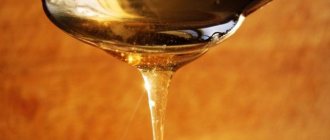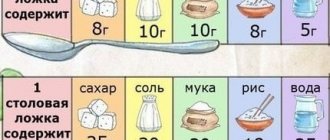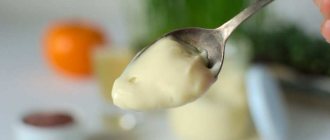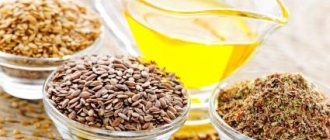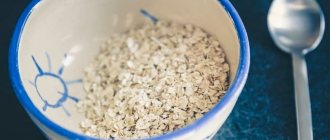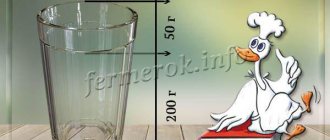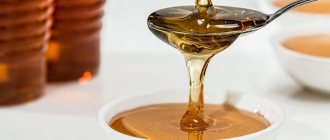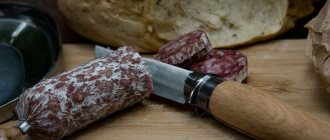How many grams in a milliliter of cream
Mass is a characteristic of a body, which is a measure of gravitational interaction with other bodies.
Volume is a quantitative characteristic of the space occupied by a body, structure or substance.
Density is a physical quantity defined as the ratio of body mass to body volume.
The relationship between milliliters and grams of cream is determined by a simple mathematical formula:
V – volume; m – mass; p – density.
In the calculation, the density of cream = 1030 kg/m3 was taken.
The density of cream can vary depending on temperature and pressure. You can find the exact density of cream in reference books.
See also the universal program for converting milliliters to grams for any substance depending on its density.
If you need to convert m3 to tons, then see the program for converting tons to m3.
If you need to convert kg to m3, then see the program for converting kg to m3.
If you need to convert liters to kg, then see the program for converting liters to kg.
Question: How many grams are in a milliliter of cream?
Answer: 1 g of cream is equal to 0.971 milliliters.
Question: How many milliliters are in a gram of cream?
Answer: 1 milliliter (ml) of cream equals 1.03 grams (g).
You can quickly solve this simple mathematical operation using our online program. To do this, enter the initial value in the appropriate field and click the button.
This page presents the simplest program for converting grams of cream to milliliters. With this online calculator you can convert milliliters of cream to grams (ml to g) and vice versa in one click.
Some recipes present the amount of ingredients in glasses, while others, on the contrary, use grams and milligrams. As a result, many housewives are at a loss as to how much food to take in this or that case. To simplify the task, you need to remember how many grams are in a faceted glass of different products.
Faceted glass capacity
Before we begin to describe the capacity of a faceted glass, we need to define what a faceted glass is. What it is? A standard faceted glass is a container 10.5 cm high. The diameter of the bottom of the faceted glass is approximately 5.5 cm, the top edge is 7.3 cm. The height of the top edge (edge) or rim is 1.4 cm. This is what a simple faceted glass looks like . The container is not even, with edges across the entire glass 1.6-2 cm wide, which is why the container got its name.
The measure of a glass with edges is 200 ml to the top edge. If you count with the edge, then 250 ml. On the market you can also find faceted containers with a volume of 50, 75, 150 ml, but it is the 200 ml glass without or with an edge that is the standard. It is in such containers that the weight of the components of different recipes is indicated.
Glass measure with edges – 200 ml to the top edge, with edge – 250 ml
If the glass is not the typical shape, has defects, or simply looks different and you have doubts about its capacity, you can check it.
- First you need to put an empty glass on the scale, the volume of which needs to be checked. You can write down the resulting number so as not to forget.
- After the first measurement, you need to fill the glass with water (if there is a rim, then water is poured before it) and weigh it again.
- If the glass has a rim, then the third weighing is carried out by pouring water to the very top.
Ordinary faceted glass
A glass with edges in the form to which we are accustomed was born more than 70 years ago. Since then, no self-respecting housewife can live without such an irreplaceable and diamond-cut vessel. And before we figure out how much of what can be poured or poured into it, let’s briefly talk about the object of our research.
Rumor has it that the prototype of a faceted glass was presented to Peter I as the strongest, unbreakable glass product. The edges just gave it strength. However, the Tsar-Father was a strong man and he broke the glass. But for some reason he liked this product, and from then on the history of the cut glass began.
Official sources claim that the primacy in the production of faceted glass belongs to the Soviet era. And it was produced in the 43rd year of the twentieth century at a glass-blowing factory in the city of Gus-Khrustalny according to the drawings of the famous sculptor of that time Vera Mukhina.
The glass was designed as a universal glassware, which, in fact, it became. The cut glass became firmly established in the life of Soviet people, and was popular in all strata of society. First of all, all public catering establishments were provided with it. Not a single office of a self-respecting boss would be complete without a decanter of water and a cut glass standing next to it.
We invite you to familiarize yourself with the design and operation of the level
Grandmothers at the market measured out fried sunflower seeds into glasses, and street soda fountains poured water into them. And even today it is impossible to imagine trains without a glass of hot tea in a beautiful glass holder. Moreover, due to the use of thick glass, it was possible to achieve the relative strength of a cut glass. Now it does not break, even if it falls onto an asphalt surface from a height of 1 meter.
A classic faceted glass has the following dimensional characteristics:
- bottom diameter – 55 mm;
- diameter at the top edge – 73 mm;
- distance from bottom to top edge – 110 mm;
- the width of the smooth rim at the top of the glass is 15 mm;
- the number of edge faces is 16-20.
Please note that the ratio of the height to the diameter of the bottom of the glass is 2 to 1, and its dimensions correspond to the anthropometric data of the human palm. This is probably why the faceted glass is so comfortable to hold in your hand.
Features of measuring weight with a glass
The measure of a glass may not correspond to the mass of a liquid or bulk product, because these are different definitions. Considering the density of the ingredient, its features, the weight will differ. For example, butter and liquid honey weigh differently due to different densities - this is important to consider! In order for the mass to be always accurate when measuring, it is worth knowing certain subtleties.
- The exact weight of water is obtained only if it is poured to the top of the container.
- Bulk ingredients cannot be compacted by hand; they must be free in the glass. Perhaps when adding flour it is worth checking to see if any voids have formed. To do this, simply stir the flour into the container with a spoon.
- To prevent viscous products from forming voids when measuring them, it is worth putting them on a spoon, and not just pouring them from the main container.
When pouring flour, it is worth checking whether voids have formed
The weight of a product is affected by many indicators, including humidity and density. Below we discuss in detail how many grams are in a faceted glass of various berries, cereals, nuts, liquids, etc.
Teahouses
Small spoons will come in handy when implementing the most daring culinary ideas. With their help, you can calculate everything according to the recipe. For example, this is especially important during canning. After all, if the cook makes a mistake in the dosage, the preparations may be spoiled.
Therefore, the main condition is to take their advice into account in order to correctly calculate how much is contained in one measure and avoid mistakes.
Loose products
To find out how much sugar is in a teaspoon, just take the information below. As a rule, if a book or website says 1 tsp, it means you can add a little more, that is, a heaping amount. Sometimes authors indicate that it should not exist. As with a tablespoon, the volume of a teaspoon in ml may vary. Accordingly, the values will also vary less or more.
If such differences affect cooking, it is advisable to determine the capacity in advance. In this way, it will be possible to calculate how much salt and other substances a weight measure contains. But in most cases, such a minor difference does not affect the result. When implementing different ideas, the main thing to take into account is that, despite the similar consistency, ground and powdered substances differ in mass. Therefore, culinary specialists advise not to measure them “by eye”. The compiled list will be useful for those who want to quickly navigate while cooking. This is an easy way to measure 50 grams of sugar, semolina or cocoa.
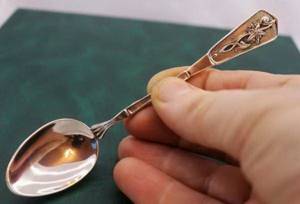
Liquids
This simple instrument is widely used for measuring water, oil, etc. It holds 5 ml. It is important to remember that regardless of the quantity, cooks pay attention to density. So, condensed milk weighs more than regular milk, etc.
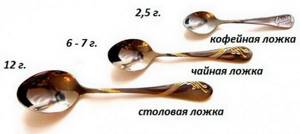
Bulk solids measurement
Bulk products include dry products that pour out uniformly from the packaging. These are, first of all, various porridges and confectionery ingredients. They have different weights, although some ingredients may have similar meanings. Below is a table of the weight of bulk products up to the edge and with the edge of the faceted glass.
| Product | Weight to rim (g) | Weight with rim (to top, in g) |
| Wheat flour | 130 | 160 |
| Granulated sugar | 160 | 200 |
| Powdered sugar | 140 | 180 |
| Potato starch | 150 | 180 |
| Oatmeal | 80 | 100 |
| Semolina | 160 | 200 |
| Millet | 175 | 220 |
| Lentils | 170 | 210 |
| Buckwheat | 165 | 210 |
| Rice | 185 | 230 |
| Pearl barley | 180 | 230 |
| Barley grits | 145 | 180 |
| Sago | 150 | 180 |
| Salt | 255 | 320 |
| Breadcrumbs | 110 | 130 |
| Lemon acid | 250 | 300 |
| Powdered milk | 100 | 120 |
| Poppy | 120 | 155 |
| Cocoa powder | 130 | 150 |
Taking these indicators into account, you can easily calculate the mass of any bulk components of a dish in glasses, without constantly using scales.
Dessert
The linear dimensions of these cutlery are something between st. and tsp. They can be used in the kitchen to determine weight on a par with electronic or mechanical scales. Before starting the calculations, cooks are advised to find out the capacity of the des. l. There are two types of such spoons:
- English (most often used in Europe and the CIS);
- American (they are used in North America).
These devices are convenient and useful in the kitchen of any housewife. The capacity of American ones is 11, and English ones are 10 ml.
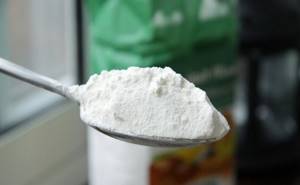
Loose ingredients
Thanks to dessert utensils, you can “weigh” almost everything in the refrigerator. To measure cereals or bran, take into account the degree of grinding. Therefore, it is difficult to determine exactly down to the milligram how much granulated sugar is in 1 dessiatine. l. An example is salt: extra weighs less than rock salt. A 1 dec. l. citric acid is 12 g.

Liquids
To measure components with a viscous and liquid consistency with this device, cooks are guided by the same principle as in previous cases. So, 1 dec. l. vinegar (regular or apple) is 10, cream – 11, jam – 27 g.
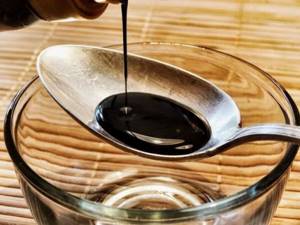
Weight of solids in a cut glass
How many grams are in a cut glass of certain solid foods? This question is asked by many housewives. Even knowing how much flour or sour cream is in a glass, it is difficult to determine the weight of beans or walnuts in the same container, because they have a different density and do not fully fill the glass. The table below will make it easier to determine the weight of different solid ingredients.
| Product | Weight to rim (g) | Weight to top (g) |
| Vermicelli | 190 | 230 |
| Peas, peeled | 185 | 230 |
| Beans, peeled | 175 | 220 |
| Dried mushrooms | 80 | 100 |
| Cherry | 130 | 165 |
| Raspberries | 110 | 140 |
| Dried rose hips | 150 | 200 |
| Cranberry | 160 | 200 |
| Dried pears | 55 | 70 |
| Strawberry | 120 | 150 |
| Currant | 140 | 175 |
| Blackberry | 150 | 190 |
| Walnuts | 130 | 165 |
| Pine nuts | 110 | 140 |
| Hazelnut | 130 | 170 |
| Peanut | 140 | 175 |
| Almond | 130 | 160 |
| Seeds | 95 | 125 |
| Raisin | 155 | 190 |
As you can see, the weight of certain products varies significantly. But it is worth remembering that only a clean, dry container is taken to accurately calculate the weight of the components of the dishes!
Measuring capacity: How many grams in a faceted glass table
Housewives have long been doing without special measurements - they bake and cook, measuring out food in a glass.
Bulk products
This type includes sugar, buckwheat, flour and much more. If you are faced with a recipe that includes bulk products in grams, then this table will become useful in your kitchen.
| Product | Glass without rim, 200 ml | Glass with rim, 250 ml |
| Sugar | 160 | 200 |
| Rice | 185 | 230 |
| Buckwheat | 165 | 210 |
| Pearl barley | 185 | 230 |
| Bulgur | 190 | 235 |
| Couscous | 180 | 225 |
| Millet | 175 | 220 |
| Peas | 185 | 230 |
| Salt | 255 | 320 |
| Semolina | 160 | 200 |
| Corn flour | 145 | 180 |
| Wheat groats | 145 | 180 |
| Barley groats | 145 | 180 |
| Wheat flour | 130 | 160 |
| Pasta | 190 | 230 |
| Oat flakes | 80 | 100 |
| Powdered milk | 100 | 120 |
| Cornflakes | 50 | 60 |
| Hercules | 60 | 75 |
Liquids
Liquid has a relatively fixed volume, making it very difficult to measure in grams. However, the table below shows the products in detail in grams.
| Product | Glass without rim, 200 ml | Glass with rim, 250 ml |
| Milk | 200 | 250 |
| Water | 200 | 250 |
| Kefir | 200 | 250 |
| Cream | 200 | 250 |
| Yogurt | 200 | 250 |
| Liquor | 200 | 250 |
| Vinegar | 200 | 250 |
| Cognac | 200 | 250 |
| Sunflower/olive oil | 185 | 230 |
| Ghee | 195 | 240 |
| Melted margarine | 180 | 225 |
| Rendered fat | 195 | 240 |
Solid foods
This table approximately shows how many grams are in a faceted glass, because the exact content will depend on the size and type.
| Product | Glass without rim, 200 ml | Glass with rim, 250 ml |
| Small lentils | 175 | 220 |
| Candied fruit | 220 | 275 |
| Sunflower seeds | 135 | 175 |
| Pumpkin seeds | 95 | 125 |
| Beans | 175 | 220 |
| Whole peas | 160 | 200 |
| Ground walnut | 155 | 190 |
| Large lentils | 160 | 200 |
| Raisin | 155 | 190 |
| Fresh blueberries | 160 | 200 |
| Dried blueberries | 110 | 130 |
| Cherry | 155 | 190 |
| Gooseberry | 165 | 210 |
| Cranberry | 155 | 190 |
| Cherries | 130 | 165 |
| Currant | 145 | 180 |
| Peeled hazelnuts | 140 | 175 |
| Peanuts, shelled | 140 | 175 |
| Peeled almonds | 135 | 170 |
| Strawberry | 135 | 170 |
| Whole shelled walnut | 135 | 170 |
| Raspberries | 120 | 150 |
Products with viscous consistency
Let's now look at the last variety of food we have left.
| Product | Glass without rim, 200 ml | Glass with rim, 250 ml |
| Honey | 260 | 325 |
| Condensed milk | 240 | 300 |
| Berry/fruit puree | 280 | 350 |
| Boiled condensed milk | 280 | 350 |
| Jam/ Jam | 275 | 340 |
| Tomato paste | 240 | 300 |
| Cottage cheese | 200 | 250 |
| Mayonnaise | 200 | 250 |
| Sour cream | 210 | 265 |
From 12 to 20
And in 1918, on the canvas “Morning Still Life” by Kuzma Petrov-Vodkin, there was a 12-sided glass of tea. Although it could have a different number of sides, from 12 to 20. The invention of the upper rounded rim is attributed to the famous USSR sculptor Vera Mukhina (she also invented the beer mug). It is believed that a container of this shape was more convenient to wash in Soviet dishwashers. Mass production of glasses began on September 11, 1943 at the glass factory in Gus-Khrustalny.
See also: 15 secrets of foil.
The glass can also be used as:
- piggy bank;
- vase;
- candlestick;
- a mold for cutting out dough;
- ashtray;
- pen stand;
- container for cotton swabs or medical instruments.
Viscous products
Viscous ingredients weigh more than bulk ingredients, since they contain a lot of liquid, pectin, and sometimes sugar. The weight of these products may be slightly or significantly greater, so do not neglect the measurement. After all, if, for example, you put less sour cream or tomato paste in a dish, the dish may not turn out well. Below is a table with the most common viscous products and their weight in a faceted glass.
| Product | Weight to rim (g) | Weight to top edge (g) |
| Sour cream | 220 | 250 |
| Tomato paste | 180 | 220 |
| Mayonnaise | 200 | 250 |
| Condensed milk | 250 | 300 |
| Boiled condensed milk | 280 | 350 |
| Liquid honey | 330 | 415 |
| Jam | 290 | 310 |
| Puree | 290 | 350 |
When calculating the mass of viscous ingredients in a glass, temperature plays a huge role. They are easier to pour when warm or even hot, so it is recommended to heat many products first and then measure their mass.
Useful tips
A cut glass is indispensable in the kitchen. It is suitable not only as a container for drinking, but also for calculating the mass of various products. It is easy for them to measure the right amount of sugar, salt, rice or other dish ingredient. So you need to keep it clean.
To measure food with a cut glass, it must be clean.
- If the glass is very dirty, you should steam it in a solution of potato broth, salt and vinegar. Warm water and baking soda also works well to remove dirt.
- To clean glasses until they shine, you can add a little vinegar to the water while washing. It will not only add shine, but also eliminate any unpleasant odors.
- To make the glass shine, after washing it can be rinsed in a solution of 4 tsp. vinegar and 2 tbsp. l. salt.
- After measuring vegetable oil or melted lard, you can remove fat from the walls by wiping it with mustard powder.
- To prevent glasses from taking up much space, they are often placed inside each other. It's convenient, but sometimes they stick together. What to do? Simply place the containers in hot water and put an ice cube in the top glass. Due to the temperature difference, they will quickly separate.
- It can be difficult to remove stains from dairy products or eggs on a glass. The easiest way to do this is to first rinse it in cold water and then wash it in hot water.
- To prevent streaks from remaining on the glass after washing, you can immediately wipe them dry with a cotton towel.
- If a washed glass is immediately placed in a cabinet, condensation may form. To prevent this from happening, the container is first placed on a plate for 10-15 minutes and then put away in the closet.
How many grams are in a faceted glass of a certain product is important for every housewife to know. Many people make memorable notes in cookbooks or hang printed charts on the wall. The main thing is to always have such information at hand, then cooking will be a pleasant entertainment and not a hassle.
